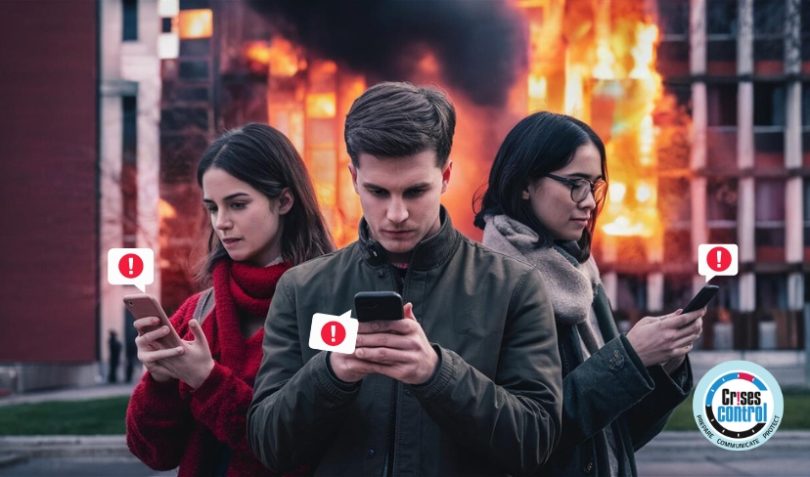Written by Anneri Fouriel | Marketing Executive
In today’s fast-paced and unpredictable world, the safety of employees is paramount. Organisations need to be ready to respond swiftly and efficiently to any crisis, whether it’s severe weather, fire, or other emergency situations. One crucial tool in this preparedness toolkit is an emergency mass notification system. But what exactly is it, and how can it benefit your organisation? Let’s dive into the details.
Understanding Emergency Mass Notification Systems
What is an Emergency Mass Notification System?
An emergency mass notification system is a communication solution designed to alert and inform large groups of people about emergencies. These systems can disseminate messages across various channels such as SMS, email, voice calls, and mobile apps, ensuring that critical information reaches everyone promptly, regardless of their location or device.
How Does It Work?
- Initiation: When a crisis occurs, authorised personnel can quickly initiate an alert through the emergency notification system interface. This can be done via a web-based platform or a dedicated mobile app.
- Message Crafting: Pre-configured templates can be used to create clear and concise messages, tailored to the specific type of emergency, or you can create your own message tailored to your audience.
- Multi-Channel Communication: The message is then sent out simultaneously via multiple channels—SMS, emails, voice calls, and push notifications on mobile apps—ensuring maximum reach.
- Confirmation and Tracking: The system tracks message delivery and receipt, providing real-time analytics and confirmation of who has received and acknowledged the alert. You can use these receipts to identify who has not received or responded to the alert message and re-notify them.
Benefits of an Emergency Mass Notification System
Implementing an emergency mass notification system provides numerous benefits that can significantly enhance an organisation’s crisis management capabilities.
Enhanced Communication
- Speed and Efficiency: Emergency notification systems ensures that critical information is disseminated swiftly, reducing the time it takes to alert employees about an emergency.
- Multi-Channel Delivery: By leveraging multiple communication channels, a mass alert system increases the likelihood that messages will be received promptly.
Improved Safety and Security
- Immediate Response: Rapid notification allows employees to take immediate action, potentially saving lives and reducing injury.
- Geolocation Features: Some systems include geolocation, helping to identify and communicate with individuals in the affected area specifically.
Compliance and Accountability
- Regulatory Compliance: Many industries have regulatory requirements for emergency preparedness. Mass alert systems help organisations stay compliant by ensuring that emergency protocols are followed.
- Audit Trails: The system’s tracking capabilities provide an audit trail, documenting who was notified and when, which is crucial for post-incident reviews and insurance policies.
Types of Crises Addressed by Emergency Mass Notification Systems
Natural Disasters
Severe weather conditions such as hurricanes, tornadoes, and earthquakes can be unpredictable and devastating. An emergency mass notification system can alert employees about the imminent danger and provide instructions on how to stay safe.


Fire and Safety Hazards
In the event of a fire or other safety hazards, rapid notification is essential to evacuate the premises and ensure everyone’s safety. Emergency notification systems can provide real-time updates on the situation and any changes to evacuation plans.
Health Emergencies
During health emergencies like pandemics or widespread illness outbreaks, timely communication is critical. Emergency notification systems can disseminate health advisories, preventive measures, and updates on the situation to all employees.


Security Threats
For security threats such as active shooters or bomb threats, immediate and clear communication is vital to guide employees to safety and keep them informed as the situation unfolds.
How Crises Control Can Help
Crises Control offers a robust and reliable emergency mass notification system designed to meet the diverse needs of modern organisations. Here’s how we stand out:
Comprehensive Solution
Our platform is an all-in-one solution that not only provides mass notification capabilities, but also includes crisis management tools to streamline your response.
- User-Friendly Interface: Our system is easy to use, ensuring that even in high-stress situations, alerts can be sent out quickly and efficiently.
- Customisable Templates: We offer pre-configured message templates for different types of emergencies, which can be customised to suit your specific needs.
Advanced Features
- Real-Time Tracking and Analytics: Monitor message delivery and receipt in real-time, and generate detailed reports for post-crisis analysis.
- Geolocation Services: Target messages to specific geographic areas, ensuring that those in immediate danger receive the information they need.
Mobile Integration
Our emergency alert app allows for seamless integration with mobile devices, ensuring that employees can receive alerts no matter where they are.
Push Notifications: Instant push notifications ensure that messages are seen quickly.
- Two-Way Communication: Employees can respond to alerts, providing valuable feedback and confirming their safety.
Real-World Applications
Crises Control’s emergency mass notification system has been successfully implemented in various industries, demonstrating its versatility and effectiveness.
Case Study: Law Firm
A specialist law firm integrated our system to enhance their emergency response capabilities. In the event of a significant incident, where immediate communication with their staff is crucial, the platform allows them to swiftly make contact. They successfully utilised the platform to notify their staff when they encounter an incident, reaching individuals on their personal mobile devices. The immediate and targeted communication ensured everyone’s safety and minimised disruption to their operations.
Case Study: Producer of Liquified Natural Gas
A major producer of liquified natural gas, based in the EMEA region, needed a reliable mass notification solution to improve their business continuity. The system ensured that their business continuity team could send immediate notifications about critical incidents to response teams, employees and key stakeholders. The multi-channel approach of the platform ensures that the message will always get through to its intended audience. Crises Control’s emergency notification system empowered them to maintain operational efficiency during a crisis and minimise potential losses.
Want to see more success stories? Explore our comprehensive case studies to discover how organisations across various industries leverage Crises Control to safeguard their employees and business continuity.
Conclusion: Stay Prepared with Crises Control
In an unpredictable world, being prepared is not just an option—it’s a necessity. An emergency mass notification system is a critical component of any robust crisis management strategy. It ensures that your organisation can respond swiftly and effectively to any emergency, keeping your employees safe and your operations running smoothly.
Crises Control offers a comprehensive, user-friendly, and reliable solution tailored to your organisation’s needs. Don’t wait for a crisis to happen—take proactive steps today to ensure the safety of your team. Contact us now to get a free personalised demo and consultation!









